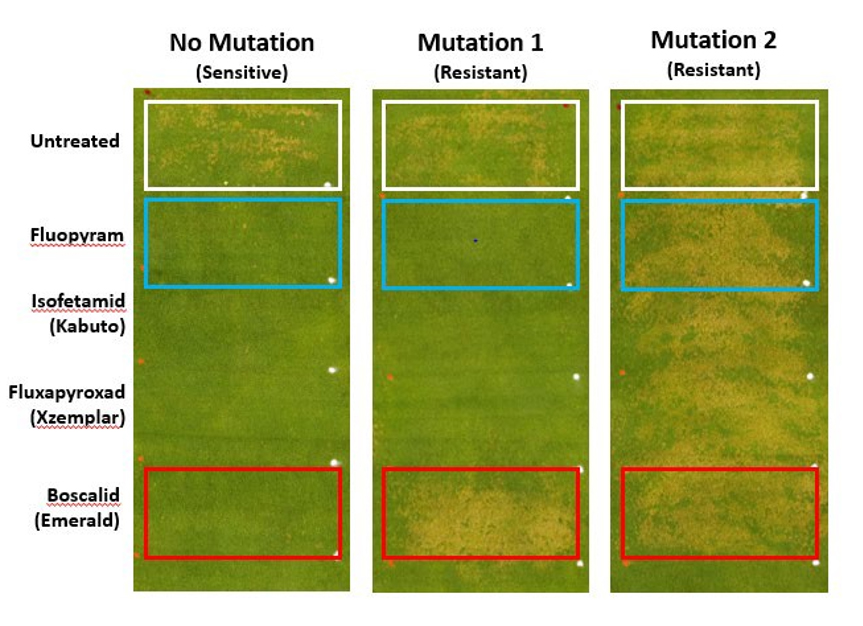If you are a golf course superintendent in the New England area, chances are you have at least one succinate dehydrogenase inhibitor (SDHI) fungicide included in your spray program. Well known for its broad spectrum of efficacy against multiple pesky diseases, the SDHI fungicide class is the fastest growing class on the market. Over the last few years, the industry has seen a widespread increase in SDHI usage on tees, greens and fairways, as new active ingredients continue to be released.
In particular, SDHIs are a very important line of defense against dollar spot, as this disease has been known to develop resistance to multiple major fungicide classes, including benzimidazoles (Cleary 3336TM), dicarboximides (Chipco 26GTTM), and demethylation inhibitors (DMIs) such as propiconazole (Banner Maxx)TM and tebuconazole (TorqueTM).
Unfortunately, the SDHI class is not immune to problems with resistance. Since 2017 there have been 5 confirmed cases of SDHI resistant dollar spot on golf courses throughout the US and Japan, with even more reports on the way. Widespread, repeated use and a highly specific mode-of-action makes SDHIs especially susceptible to resistance development.
In order to control diseases like dollar spot, SDHI’s target specific fungal respiration machinery, stopping fungal growth in its tracks. Slight changes, or mutations to the genetic code of this machinery lead to SDHI resistance, as is the case with benzimidazoles and dicarboximides. For the other fungicide classes mentioned above, however, resistance to one product within the class means resistance to all products within that class. SDHI resistance is more complex. Field and lab research results from the Turfgrass Pathology Laboratory at UMass Amherst indicate that for SDHIs, different mutations have unique patterns of resistance to various SDHI active ingredients including boscalid (EmeraldTM), fluxapyroxad (XzemplarTM), isofetamid (KabutoTM), fluopyram and pydiflumetofen (PosterityTM). Since 2017, our lab has identified 6 mutations involved in SDHI resistance in dollar spot from four different locations, each with their own patterns of resistance against 5 (and counting) SDHI active ingredients. For example, all identified mutations are completely resistant to EmeraldTM.
However, certain mutations are resistant to all registered SDHI fungicides while other mutations have maintained high sensitivity to fluopyram.
Figure 1: A 2019 inoculated field efficacy trial indicates distinct sensitivity profiles to 4 SDHI active ingredients depending on unique mutations: (left) A sensitive, non- mutated strain; (middle) a resistant, mutated strain with resistance to boscalid but sensitivity to all other SDHIs; (right) a resistant, mutated strain with resistance to all SDHIs.
Depending on the type of fungicide used, the average cost of one fungicide application over approximately 30- 40 acres of fairways can be over $1,200. To discover that your course has resistance to one or more fungicide classes only after spending that amount of money on a failed fungicide application would be devastating.
Therefore, understanding which mutations are present on your course is necessary for making informed and efficient decisions about what to include in your fungicide programs each season. Hammering any one active ingredient is, of course, never a good idea. This is especially important in the case of SDHIs. Carefully following label rates while rotating between fungicide classes with different modes-of-action is a necessary practice for delaying the development of resistance, in any case. However, if different mutations have different patterns of resistance, as is the case with SDHIs how can you know what to spray unless you know what mutation you have on site?
In 2019, our lab developed a molecular test for detecting specific mutations involved in SDHI resistance thanks to funding from the New England Regional Turfgrass Foundation (NERTF) and the United States Golf Association (USGA). Our lab offers a fee-based service to golf course superintendents and the turf industry using this molecular test in combination with in vitro assays to specifically diagnose sensitivity to multiple classes of fungicides (DMI, SDHI, dicarboximide, and benzimidazole) from dollar spot infected turf plugs. With this information, we can provide a written report outlining specific recommendations for fungicide application tailored distinctly for your course or site.
To submit samples for resistance diagnosis, turf plugs from the areas in question should be wrapped in wetted newspaper or paper towels and shipped overnight to the UMass Turf Pathology Laboratory at the following address:
UMass Turf Pathology Laboratory
161 Holdsworth Way
220 Paige Laboratory
Amherst MA, 01003
Attn: Michaela Elliott
If you have any interest in this service or have questions regarding SDHI resistance in dollar spot, please contact Michaela Elliott (melliott@umass.edu) or Dr. Geunhwa Jung (jung@umass.edu).
Submitted by: Dr. Geunhwa Jung and Michaela Elliott, Research Associate
